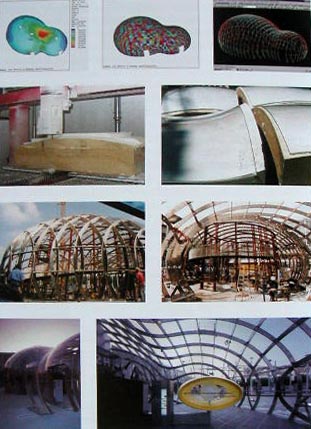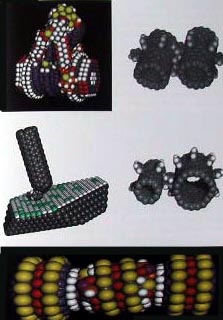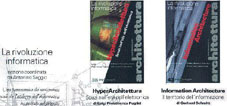"Il Come"
Prefazione di Antonino Saggio

L'informatica si sta imponendo come il paradigma centrale
per una nuova fase di tutta l'architettura. Questa collana, pensata
originariamente solo in Italia nel 1996 è giunta con questo
titolo al diciottesimo volume in italiano ed è oggi tradotta
anche in inglese, cinese e coreano.
Questa diffusione è naturalmente motivo di
grande soddisfazione per tutti noi: innanzitutto per gli autori,
per l’editore italiano Testo&Immagine che l’ha fatta nascere,
per l’editore Birkhäuser cui si deve l'edizione in Inglese, per l'editore
Cinese Prominence Publishing e infine per chi vi scrive.
Ma torniamo all’architettura e al suo così importante
rapporto oggi con l’informatica. Negli anni Settanta del Novecento i pochissimi
architetti che si occupavano di computer erano visti come un gruppo di
strampalati e irriducibili utopisti, negli anni Ottanta erano guardati
come degli specialisti che parlavano un linguaggio incomprensibile
ai più, ma negli anni Novanta - parallelamente alla diffusione dei
calcolatori in tutti gli studi di progettazione - si cominciò a
capire che proprio quegli architetti utopisti o specialisti stavano promuovendo
linee di ricerca che sarebbero state feconde di sviluppi per tutti.
Accanto ai grandi padri fondatori del Caad in Architettura
Chuck Eastman, Nicolas Negroponte e Bill Mitchell e a un gruppo di più
giovani genitori, Chris Yessios, Gerhard Schmitt o John Gero si va affermando
una generazione di architetti "Nati con il Computer".
L’ultima generazione a cavallo tra il vecchio e il
nuovo è stata la mia, apertasi all'informatica quando eravamo trentenni
in quella grande fucina di ricercatori di Computer Science che è
stata la Carnegie-Mellon di Pittsburgh. In quei primi anni Ottanta, mentre
i primi robot saltellavano nei viali del campus ci domandavamo come l'informatica
avrebbe cambiato l'architettura. Oggi cominciamo ad avere le idee chiare
e siamo soprattutto di fronte a generazioni ancora più giovani,
che hanno nel computer non un’arma in più ma semplicemente l’arma
principale per pensare e costruire. Sì anche costruire, perché
ormai sono nate le prime realizzazioni di edifici e di spazi concepiti
attraverso la nuova sensibilità digitale. Si tratta di edifici non
soltanto progettati e realizzati con il calcolatore ma pensati per essere
segnali significativi per individuare le linee sulle quali si sta orientando,
appunto, una nuova fase informatica dell'architettura.
Questo libro si chiama non a caso "Dietro le quinte.
Tecniche di avanguardia nella progettazione contemporanea". Scritto da
due appassionati ricercatori italiani, Francesco De Luca e Marco Nardini
ha lo scopo di svelare quasi passo per passo quali sono le modalità
per avvicinare la progettazione architettonica utilizzando l'informatica
per aprire nuovi campi di indagine.
Nascono in questo spirito le sezioni sulle Polisuperfici,
sul Keyframing, sul Morphing sul Metaball, sui Sistemi particellari e altre
ancora sui sistemi dinamici, aperti e interconnessi che sposano scienza
contemporanea e informatica.
Per l'utilizzatore abituale di queste tecniche, la
prima parte di questo libro è forse solo una utile sintesi, ma per
una grande massa di architetti giovani e meno giovani la spiegazione
diffusa e dettagliata di queste tecniche di indagine costituirà,
ne sono certo, un ausilio di grande utilità. Il libro nasce infatti
anche per assolvere una domanda dal basso. Studiando i libri della
collana, molti lettori sono stati affascinati dai lavori dei nuovi architetti,
ne hanno visto gli esiti e hanno allo stesso tempo analizzato il background
teorico che ne motivava le ricerche. Ma mancava l'elemento intermedio:
il "come". Ecco questo libro cerca di spiegare questo "come" scegliendo
quelle aree in cui i paradigmi dell'informatica permettono di ideare progetti
architettonici più aderenti alla complessità dell'oggi. Per
cogliere il significato della seconda parte di "Dietro le quinte" dobbiamo
tornare però al disegno complessiva della collana.
Informazione e Interattività
La dizione Rivoluzione Informatica in architettura
è stata scelta per sottolineare un implicito parallelismo. Negli
anni Venti del Novecento architetti come Walter Gropius o Le Corbusier
o Mies van Der Rohe ebbero la capacità di riformulare "completamente"
l’architettura sulla spinta del nuovo mondo meccanico e industriale. Fu
una rivoluzione perché l'architettura modificò allora tutti
i parametri del proprio operare assorbendo i processi seriali, razionali,
standardizzabili e tipizzabili della produzione industriale. L'architettura
fece propri questi processi sia interiorizzandoli come metodo di lavoro,
sia assumendoli come parametri "oggettivi" per valutare o meno il raggiungimento
di una nuova qualità.
Oggi siamo in un epoca diversa. Le parole chiave degli
architetti sono cambiate: si pensa in termini di "personalizzazione"
e non più di "standardizzazione", non più attraverso processi
"di divisone in cicli" o di "catena di montaggio", ma di "unità
tra diversi", la città non è più concepita per zone
monofunzionali (qui si lavora, qui si risiede, qui ci si svaga) ma in un
insieme interagente di usi e funzioni, non si pensa più all’idea
di "modello ripetibile" (la Ford Nera per tutti o l'Unité d'Habitation)
ma in termini di Adattabilità e di Individualizzazione.
La rete, i sistemi informativi per l'ideazione
e la progettazione degli edifici, i materiali e i modi stessi della costruzione
stanno cambiando l'essenza dell'architettura. Gli spazi tendono a essere
sempre più multifunzionali e sono ideati attraverso geometrie
complesse, la costruzione è realizzata con una sorta di "artigianato
informatico" con pezzi speciali creati attraverso frese guidate da modelli
digitali, ma soprattutto è l'informazione che sta diventando
componente essenziale di una nuova architettura e di un nuovo ambiente
urbano. In particolare gli architetti d'avanguardia stanno cercando di
concepire una generazione di edifici e di spazi che abbiano "coscienza"
del cambiamento del quadro operativo e sociale che l'informatica
conduce e che siano capaci di esprimere questa rivoluzione.
Si sta cercando di capire come creare un interfaccia
tra computer e utenti (e non più come è stato per una decina
d'anni tra utenti e computer). Si sta cercando di capire come far
interagire il computer con gli uomini e con l'ambiente attraverso
l'utilizzo di sensori di tutti i tipi: da quelli meccanici e quantitativi
(che misurano aria, luce o temperatura) ad altri più complessi (capaci
di interpretare espressioni o il tono della voce), ad altri ancora più
sofisticati che riescono a formulare delle ipotesi su quello che "sentiamo
emozionalmente". Questa frontiera è anche per un gruppo sparuto,
ma essenziale, di architetti una ricerca fondamentale per far mutare interattivamente
l'architettura al mutare delle situazioni e dei desideri.
E' proprio alla comprensione anche "tecnica" di questo
mondo che è rivolta la seconda parte del libro. E ciò è
fatto sia con l'analisi in dettaglio del mondo dei sensori e dei sistemi
interattivi sia attraverso la delineazione della logica complessiva di
un nuovo ambiente. Un ambiente a metà naturale a metà artificiale
consentito e sviluppato dai nuovi media.
"How"
foreword by Antonino Saggio

During the 1970s, the few architects who worked with
a computer were seen as a group of strange, determined Utopians. During
the 1980s, they were looked upon as specialists who spoke a language incomprehensible
to most. But during the 1990s ? parallel to the widespread expansion of
computer use in design studios ? the understanding also grew that those
Utopian or specialist architects were following lines of research that
would become fertile ground for new developments for everyone.
Along with the great founding fathers of CAAD use
in architecture (Chuck Eastman, Nicolas Negroponte, Bill Mitchell and the
group of younger fathers, Chris Yessios, Gerhard Schmitt and John Gero),
a new generation of architects "Born with the Computer" made itself known.
Mine was the last generation to straddle the old and the new, to open ourselves
up to computers when we were in our thirties in that great hotbed of Computer
Science researchers that was Carnegie-Mellon in Pittsburgh. In those early
years of the 1980s, while the first robots roamed the campus alleyways,
we asked ourselves how computers would change architecture. Today, we begin
to have clear ideas and are more importantly facing an even younger generation
who sees the computer as not just an extra device but quite simply the
main tool for both designing and building; yes, even building, because
the first constructions have now been made of buildings and spaces conceived
using this new digital sensibility. These buildings are not only "designed
and built with the computer" but also aim at being significant signs for
identifying the contemporary lines of orientation, the new information
phase in architecture.
This book is called, not by chance, Behind the Scenes.
Avant-garde techniques of Contemporary Design. Written by two enthusiastic
young Italian researchers, Francesco De Luca and Marco Nardini, it aims
at revealing almost step by step the methods for approaching architectural
design using Information Technologies to open new fields of investigation.
Born out of this spirit are sections on Polysurfaces, Keyframing, Morphing,
Metaballs, Particle Systems and still others on interconnected, open and
dynamic systems that bring together contemporary science and computers.
For regular users of these techniques, the first part of this book may
be only a useful synthesis, but for the great masses of young, and not
so young, architects, I am certain the broad ranging and detailed explanation
of these techniques of investigation will constitute a very useful aid.
The book was in fact created to resolve a question from below. Studying
the books in this series, many readers have been fascinated by the work
of new architects, have seen the results and at the same time analyzed
the theoretical background that motivated the research. But an intermediate
element was missing: the "how". And so this book attempts to explain "how"
by choosing areas in which the paradigms of Information Technology help
create architectural projects more in keeping with today’s complexities.
To grasp the meaning of the second part of "Behind the Scene", we must
however go back to the overall design of this book series.
Information and Interactivity
Though originally planned in 1996 to be only in Italian,
with this issue the series has now reached its eighteenth volume in English
and is presently also translated into Chinese. All of us are naturally
very satisfied about this: not only the authors, but also the Italian publisher
Testo & Immagine who originated the series, Birkhäuser Publishers
for the English version, the Chinese publisher Prominence Publishing and
finally this writer who, as you know, is the creator and curator of the
series.
The definition "Information Technology Revolution"
was chosen to underline an implicit parallelism. During the 1920s, architects
such as Walter Gropius or Le Corbusier or Mies van der Rohe "completely"
reformulated architecture under the influence of the new mechanical, industrial
world. Their architecture was revolutionary because it modified all the
operating parameters of the era, absorbing the serial, rational, uniform
and standardizable processes of industrial production. Architecture performed
these processes both by internalizing them as work methods as well as assuming
them as "objective" parameters to evaluate whether or not new qualities
had been achieved.
We are now in another era. The key words of architects
have changed. They no longer think in terms of "standardization" but "personalization";
no longer via processes of "division into cycles" or "assembly lines" but
of "unity among differences". The city is no longer conceived in monofunctional
zones (work here, live here, play here) but as an interactive whole of
uses and functions, no longer considering the idea of the "repeatable model"
(the Black Ford or Unité d'Habitation) but rather the concepts of
Adaptability and Individualization.
The network, the information systems for designing
and planning buildings, construction materials and even methods themselves
are changing the essence of architecture. Spaces tend toward being more
and more multifunctional and are created using complex geometry. Construction
is done through a sort of "computerized craftsmanship" with special pieces
made using routers and lathes guided by digital models. But it is information
above all that is becoming an essential component of the new architecture
and new urban environment. In particular, forward-looking architects are
attempting to create a generation of buildings and spaces that are "conscious"
of the changes in the operational and social framework caused by information
technology and capable of expressing this revolution. There is an attempt
to understand how an interface can be created between computer and user
(and no longer between user and computer as it was for decades). Attempts
are being made to understand how to make the computer interact with us
humans and the environment by using various types of sensors: mechanical
and quantitative ones that measure air, light or temperature; more complex
ones able to interpret facial expressions or a tone of voice; and others
even more sophisticated that manage to formulate hypotheses about what
we might emotionally "feel". For a small, but essential, group of architects,
this frontier is also a fundamental attempt to make architecture change
interactively with changing situations and desires. The second part of
this book is aimed precisely at understanding this world, including
the "technical" viewpoint.
This is done both through a detailed analysis of the
realm of sensors and interactive systems as well as by outlining the overall
logic of a new environment; an environment that is half natural and half
artificial, created and developed by new forms of media.




